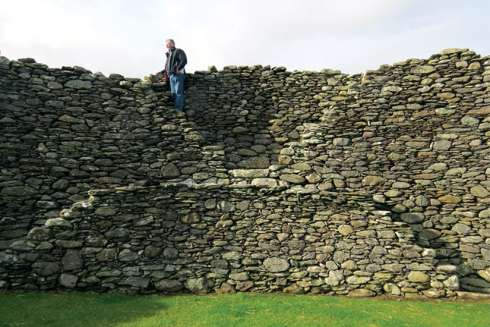Discovering less well-known, but interesting, places gives one a feeling of accomplishment finding unpolished touristy gems. Happily, we found a few and here are three.
St. Peter’s Church in Drogheda
Besides it being a beautiful church in French Gothic style with an imposing 70-metre spire, it also houses a holy relic — the preserved head of St. Oliver Plunkett is on display next to the altar.
 The preserved head of St. Oliver Plunkett is on display at St. Peter’s Church in Drogheda. (Photo by Robert Brehl)
The preserved head of St. Oliver Plunkett is on display at St. Peter’s Church in Drogheda. (Photo by Robert Brehl)
Plunkett was a remarkable man (1625-1681) who lived during the period of the Penal Laws when the Catholic Church in Ireland was subject to British policy that varied from toleration to outright persecution. It was an incredibly difficult time for Catholics while he was archbishop of Armagh. To tend to his flock and avoid the British, at different times Plunkett had to go into hiding, almost starving at one time.
In 1679, the British arrested him on trumped-up charges of treason. False witnesses testified against him but even a Protestant jury in Ireland would not convict him. He was then transferred to London where he was again tried for treason, convicted and sentenced to death.
On July 1, 1681, he was hanged, drawn and quartered in a scandalous travesty of justice. Friends rescued his head and since 1921 it has rested in St. Peter’s Church. In 1979, Pope John Paul II visited Drogheda and prayed before this relic.
Staigue Fort
On the Ring of Kerry overlooking the Dingle Bay is one of the largest stone forts in Ireland. Staigue Fort was built 1,500 years ago by a chieftan before Christianity and St. Patrick arrived in Ireland.
Several things about the old fort are rather incredible. It stands today six metres high and four metres thick and no mortar was used; stones and rocks were immaculately laid out to build it. It is 30 metres in diameter with covered sleeping quarters against the inner wall. It is also perched overlooking a valley and you can see for miles in all directions, including down to the water where enemy ships would appear.
Be forewarned: to find Staigue Fort you need a GPS in your car because it is four kilometres off the main road and to get there you need to follow one-lane dirt roads. The fort is not staffed, at least not in winter. Instead, a locked metal box is on a post for donations. It’s an adventure to find Staigue Fort and a quiet place to sit and think or picnic.
Derrynane House
Located on the scenic Iveragh Peninsula on the Ring of Kerry, Derrynane is the ancestral home of Daniel O’Connell, lawyer, politician and statesman and the man most responsible for the Catholic Emancipation Act of 1829. O’Connell was known as The Liberator or The Emancipator.
Today, Derrynane is part of a 130-hectare National Park with beautiful gardens, including rare South American plants and palm trees, and 6.3 kilometres of hiking trails and 1.5 kilometres of shoreline. The house, which has many displays and relics of O’Connell’s life and career, is open for guided and self-directed tours. While the grounds are open all-year, the home tours are available from March 5 to Dec. 13.
Exploring the Emerald Isle
Read other stories from Robert Brehl below:
- Irish rebels with a cause not forgotten
- A tale of two cities

